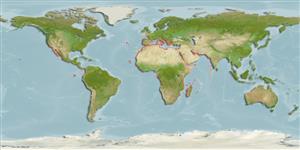Common names from other countries
Environment: milieu / climate zone / depth range / distribution range
Écologie
; saumâtre; profondeur 0 - 2 m (Ref. 80843). Tropical, preferred 23°C (Ref. 107945); 52°N - 35°S, 123°W - 75°E
Circumglobal.
Length at first maturity / Taille / Poids / Âge
Maturity: Lm ? range ? - ? cm Max length : 1.5 cm TL mâle / non sexé; (Ref. 101378)
Inhabits extreme environments such as salt lakes or brine waters, coastal or inland (Ref. 105262), just like saline lakes, and coastal salterns (Ref. 105501). Its nauplii is an irreplaceable live feed for marine and shrimp larvae. Latent eggs cysts are known to withstand long drought periods at severe hypersalinity (Ref. 105261). In an experiment, adults are fed with the dinoflagellate Gyrodinium corsicum and Cryptophyta Rhodomonas baltica (Ref. 105262).
Life cycle and mating behavior
Maturité | Reproduction | Frai | Œufs | Fécondité | Larves
Reproduction mode may be oviparous or oviviparous, depending on environmental conditions. Copulation is present. Life cycle: Eggs may either develop into nauplia (larvae) or may stay as cysts (dormant) to survive the drought period before hatching into nauplia.
Bisby, F.A., M.A. Ruggiero, K.L. Wilson, M. Cachuela-Palacio, S.W. Kimani, Y.R. Roskov, A. Soulier-Perkins and J. van Hertum. 2005. (Ref. 19)
Statut dans la liste rouge de l'IUCN (Ref. 130435)
statut CITES (Ref. 108899)
Not Evaluated
Not Evaluated
Utilisations par l'homme
Pêcheries: commercial; Aquaculture: commercial
FAO - Aquaculture: production; pêcheries: landings | FishSource | Sea Around Us
Outils
Plus d'informations
Taille/ÂgeCroissanceLongueur-poidsLongueur-longueurMorphologieLarvesAbondance
Sources Internet
Estimates based on models
Catégorie de prix
Unknown.
